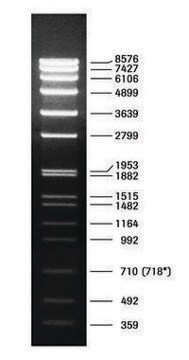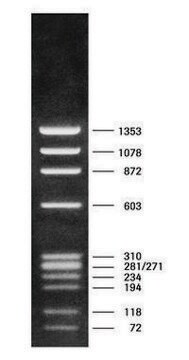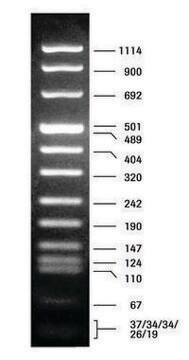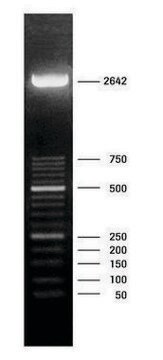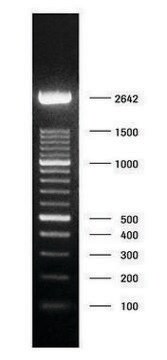11062590001
Roche
DNA Molecular Weight Marker VI
pkg of 50 μg (in 200 μl), solution
Sinônimo(s):
DNA marker
Faça loginpara ver os preços organizacionais e de contrato
About This Item
Código UNSPSC:
41105335
Produtos recomendados
forma
solution
Nível de qualidade
embalagem
pkg of 50 μg (in 200 μl)
fabricante/nome comercial
Roche
concentração
250 μg/mL
cor
colorless
solubilidade
water: miscible
temperatura de armazenamento
−20°C
Descrição geral
DNA Molecular Weight Marker VI is a fragment mixture prepared by cleavage of pBR328 DNA with restriction endonucleases Bgl I and pBR328 DNA digested with Hinf I. It has a size range of 0.15 to 2.1kbp.
The product is also available as DNA Molecular Weight Marker VI, Digoxigenin-labeled.
The product is also available as DNA Molecular Weight Marker VI, Digoxigenin-labeled.
Especificidade
Specificity: Product has 5′-phosphorylated ends (restriction fragments).
Restriction site: Claevage sites and corresponding fragment lengths of pBR328:
- Bgl I cut sites at: 935, 1169, 2399, 4575, 4809 => creating following fragment sizes, respectively: 234 bp, 1230 bp, 2176 bp, 234 bp, 1033 bp.
- Hinf I cut sites at: 632, 852, 1006, 1304, 1757, 2274, 4040, 4434, 4732, 4886. =>
creating following fragment sizes, respectively: 220 bp, 154 bp, 298 bp, 453 bp, 517 bp,
1766 bp, 394 bp, 298 bp, 154 bp, 653 bp
Restriction site: Claevage sites and corresponding fragment lengths of pBR328:
- Bgl I cut sites at: 935, 1169, 2399, 4575, 4809 => creating following fragment sizes, respectively: 234 bp, 1230 bp, 2176 bp, 234 bp, 1033 bp.
- Hinf I cut sites at: 632, 852, 1006, 1304, 1757, 2274, 4040, 4434, 4732, 4886. =>
creating following fragment sizes, respectively: 220 bp, 154 bp, 298 bp, 453 bp, 517 bp,
1766 bp, 394 bp, 298 bp, 154 bp, 653 bp
Aplicação
DNA Molecular Weight Marker VI is used for the size determination of DNA in agarose gels. It simplifies accurate molecular weight determination of double-stranded DNA fragments generated by:
- Restriction digests
- PCR
- RT-PCR
Sequência
As determined by computer analysis of the pBR328 sequence, the mixture contains 15 DNA fragments with the following base pair lengths (1 base pair = 660 daltons) occuring once: 220, 394, 453, 517, 653, 1033, 1230, 1766, 2176 and fragments 154,234, and 298 occuring twice as a result of the digestion of pBR328 with both Bgl I and Hinf I.
Note: Fragment lengths are derived from computer analysis of the DNA sequence. Depending on the size range of the marker, the smallest fragments will only be visible on overloaded gels.
Note: Fragment lengths are derived from computer analysis of the DNA sequence. Depending on the size range of the marker, the smallest fragments will only be visible on overloaded gels.
Definição da unidade
50 μg = 1A260 unit
forma física
Ready-to-use solution, 250μg/ml, in TE buffer (10mM Tris-HCl, 1mM EDTA, pH 8.0).
Nota de preparo
Storage conditions (working solution): 2 to 8 °C
Once thawed we recommend further storage at 2 to 8 °C.
Once thawed we recommend further storage at 2 to 8 °C.
Outras notas
For life science research only. Not for use in diagnostic procedures.
Código de classe de armazenamento
12 - Non Combustible Liquids
Classe de risco de água (WGK)
nwg
Ponto de fulgor (°F)
does not flash
Ponto de fulgor (°C)
does not flash
Certificados de análise (COA)
Busque Certificados de análise (COA) digitando o Número do Lote do produto. Os números de lote e remessa podem ser encontrados no rótulo de um produto após a palavra “Lot” ou “Batch”.
Já possui este produto?
Encontre a documentação dos produtos que você adquiriu recentemente na biblioteca de documentos.
Os clientes também visualizaram
G Meulemans et al.
Avian pathology : journal of the W.V.P.A, 30(6), 655-660 (2001-12-01)
A polymerase chain reaction combined with restriction enzyme analysis was developed for detection and differentiation of all 12 fowl adenovirus (FAdV) serotypes representing the five fowl adenovirus (A to E) species. For primer design, the published sequences of the hexon
Qualitative PCR?ELISA protocol for the detection and
typing of viral genomes
typing of viral genomes
Monica Musiani
Nature Protocols (2007)
R Ferretti et al.
Applied and environmental microbiology, 67(2), 977-978 (2001-02-07)
A PCR-based method for the detection of Salmonella spp. in food was developed. The method, set up on typical salami from the Italian region of Marche, is sensitive and specific and shows excellent correlation with the conventional method of reference
Nossa equipe de cientistas tem experiência em todas as áreas de pesquisa, incluindo Life Sciences, ciência de materiais, síntese química, cromatografia, química analítica e muitas outras.
Entre em contato com a assistência técnica